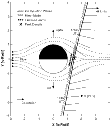 |
Figure 1. Overview of the Galileo-Io flyby geometry showing the locations of the mirror mode and ion cyclotron wave observations. (Figure adapted from Russell et al. [1997], and velocity vectors taken from Frank et al. [1996].) |
Abstract. The mirror mode is typically excited in high-beta plasmas when there is a significant pressure anisotropy, with the greatest plasma pressure perpendicular to the magnetic field, B. Large-amplitude mirror-mode structures were identified in the Galileo magnetic field data on the edges of the cold Io wake. Here, despite the high ambient B field and low plasma beta, the enhanced perpendicular pressure due to the ring-type velocity distributions of heavy Iogenic pickup ions overcomes the instability threshold for the mirror mode and provides the free energy. In the center of the Io wake, the local pickup velocities are very low and hence the perpendicular pressure contribution is small, while farther from Io in the torus, the corotating isotropic plasma dominates and the mirror mode is not unstable but instead ion cyclotron waves grow. Thus the spatial region in which the mirror mode dominates is narrow. A warm plasma dispersion analysis is performed for the multispecies plasma conditions appropriate to the edges of the Io wake. In a multispecies plasma, multiple ion cyclotron modes are possible, each with a growth rate dependent upon the anisotropy and free energy provided by the specific gyroresonant ion species component. However, the mirror mode can dominate, since its growth rate depends on the combined anisotropic pressure of all ions present.
1. Introduction
The Io-Jupiter interaction is unique in our solar system. The continual supply of volcanic
materials from Io (most notably sulfur dioxide, oxygen, sulfur, hydrogen, and sodium) to the Io torus and beyond is well
known to be the major source of plasma in the Jovian magnetosphere. The torus plasma consists predominantly of sulfur and
oxygen ions [e.g., Bagenal, 1994], consistent with rapid dissociation of sulfur dioxide [e.g., Smyth and
Marconi, 1998, and references therein] on timescales much shorter than the corotation time but closer to the ion pitch
angle scattering timescale [Huddleston et al., 1998a]. In the near-Io torus, in common with other pickup
environments (such as comets; see, for example, reviews by Galeev [1991] and Lee [1992]), newly ionized
particles are picked up into ring or ring-beam type velocity distributions which are highly anisotropic and unstable to wave
generation. During the Galileo spacecraft's close approach to Io in December 1995, several wave phenomena were observed by
the magnetometer instrument [e.g., Kivelson et al., 1996; Russell et al., 1999]. Ion cyclotron waves near the
sulfur dioxide gyrofrequency are dominant in the near-Io torus [Kivelson et al., 1996; Huddleston et al.,
1997, 1998a; Warnecke et al., 1997]. On the edges of the cold Io wake, where pickup ion densities are increasing
rapidly near the Io source [Frank et al., 1996; Bagenal, 1997], large-amplitude mirror-mode structures have
been identified. Figure 1 shows a schematic overview of the location of these observations along the Galileo flyby
trajectory. The observed mirror structures are highly com-pressional, with wave normals at large angles to B, and
their detailed properties are discussed in a companion paper [Russell et al., this issue]. The focus of the present
paper is to explain the appearance of these structures by considering the instability criterion and by evaluating dispersion
solutions for different values of the pressure anisotropy for the ion species components present near Io.
 |
Figure 1. Overview of the Galileo-Io flyby geometry showing the locations of the mirror mode and ion cyclotron wave observations. (Figure adapted from Russell et al. [1997], and velocity vectors taken from Frank et al. [1996].) |
The mirror mode is typically excited in high-beta plasmas ( is the ratio of plasma to magnetic pressures) when there exists a significant pressure anisotropy, P
is the ratio of plasma to magnetic pressures) when there exists a significant pressure anisotropy, P / P// > 1, such as that created by pickup ion ring distributions. The mirror mode
[Chandrasekhar et al., 1958; Barnes, 1966; Hasegawa, 1975] is a nonpropagating mode, with zero real
frequency. It is often thought to be a fluid instability (in the long-wavelength limit), but Southwood and Kivelson
[1993] have pointed out that the instability mechanism requires the inclusion of kinetic effects. Both fluid and kinetic
theories give the same instability threshold, but an analysis of the growth rates should use a kinetic approach, as we do
here. Maximum growth rates for the mirror mode occur at oblique angles (
/ P// > 1, such as that created by pickup ion ring distributions. The mirror mode
[Chandrasekhar et al., 1958; Barnes, 1966; Hasegawa, 1975] is a nonpropagating mode, with zero real
frequency. It is often thought to be a fluid instability (in the long-wavelength limit), but Southwood and Kivelson
[1993] have pointed out that the instability mechanism requires the inclusion of kinetic effects. Both fluid and kinetic
theories give the same instability threshold, but an analysis of the growth rates should use a kinetic approach, as we do
here. Maximum growth rates for the mirror mode occur at oblique angles ( kB) to B, in contrast to the ion cyclotron mode, whose maximum growth is at
kB) to B, in contrast to the ion cyclotron mode, whose maximum growth is at  kB = 0o.
kB = 0o.
Early observations of magnetic field perturbations in the Earth’s magnetosheath were interpreted as either very low frequency slow-mode waves or plasma condensations driven unstable by a mirror instability [Kaufmann et al., 1970]. Such structures were subsequently attributed to the mirror mode [Tsurutani et al., 1982; Hubert et al., 1989]. In addition to Earth magnetosheath observations, mirror mode structures have now been identified at comet Halley [Russell et al., 1991, and references therein; Glassmeier et al., 1993], in the solar wind [Winterhalter et al., 1994; Tsurutani et al., 1992], and in the magnetosheaths of Saturn [Tsurutani et al., 1982; Violante et al., 1995; Bavassano-Cattaneo et al., 1998] and Jupiter [e.g., Tsurutani et al., 1982; Balogh et al., 1992; Tsurutani et al., 1993]. In many of these environments, a critical question is where and how the mirror mode can dominate over the ion cyclotron mode. In the presence of ring-type pickup ion distributions, the gyroresonant modes are generally more unstable than the mirror mode, which has a higher anisotropy threshold, and in any given plasma the fastest growing mode will be observed.
At Io one might not immediately expect the mirror instability because the high ambient B of
Jupiter's magnetosphere at the location of Io's orbit dictates that the plasma  is generally low in the torus. However, kinetic theory and numerical simulations for an electron-proton plasma [McKean
et al., 1992] have found that for moderate (rather than very high) ion plasma
is generally low in the torus. However, kinetic theory and numerical simulations for an electron-proton plasma [McKean
et al., 1992] have found that for moderate (rather than very high) ion plasma  and anisotropies, the ion cyclotron and mirror modes can produce similar turbulence levels, while at very high values of
either parameter the ion cyclotron mode dominates. Also, models and numerical simulations [Price et al., 1986;
Gary, 1992; Gary et al., 1993; Anderson and Fuselier, 1993] have found that the addition of helium ions
to a proton-electron plasma reduces the proton ion cyclotron growth without significant effect on the mirror mode, and
linear theory can account for the transition between cyclotron and mirror-mode dominance under these conditions [Gary et
al., 1993]. This suggests to us that the multicomponent plasma composition might be the key to understanding the
appearance of mirror-mode structures at Io.
and anisotropies, the ion cyclotron and mirror modes can produce similar turbulence levels, while at very high values of
either parameter the ion cyclotron mode dominates. Also, models and numerical simulations [Price et al., 1986;
Gary, 1992; Gary et al., 1993; Anderson and Fuselier, 1993] have found that the addition of helium ions
to a proton-electron plasma reduces the proton ion cyclotron growth without significant effect on the mirror mode, and
linear theory can account for the transition between cyclotron and mirror-mode dominance under these conditions [Gary et
al., 1993]. This suggests to us that the multicomponent plasma composition might be the key to understanding the
appearance of mirror-mode structures at Io.
The investigation of pickup ion instabilities has been investigated in some detail at comets.
Brinca [1991] provides a useful review of many of the features of cometary pickup ion instabilities, including a
discussion of the strong dependence on composition. For example, Brinca and Tsurutani [1987] discuss the effects of
pickup oxygen ions, finding growth near the oxygen gyrofrequency. Furthermore, Brinca and Tsurutani [1989] show that
multiple pickup ion species can act in concert to drive fluid-like instabilities, while leaving the growth near each species
gyrofrequency relatively unaffected, unless the different species have similar masses. As will be shown here, similar
effects are found at Jupiter, but the results are further complicated by the presence of thermalized pickup ions that act to
damp the cyclotron modes of the dissociated species. Additionally, once developed, the spatial structure of the mirror mode
itself may cause the ion cyclotron resonance condition to become position-dependent and thus inhibit the resonance
efficiency, as suggested by Southwood and Kivelson [1993]. The nonlinear model of Pantellini [1998] finds
that for  < 10, the evolved mirror-mode structures take the form of narrow, deep magnetic wells, as has been observed. In this
paper we examine the instability criterion and perform a warm plasma dispersion analysis for conditions appropriate to the
location of the mirror-mode observations near Io and discuss why they are confined to the narrow wake-edge regions.
< 10, the evolved mirror-mode structures take the form of narrow, deep magnetic wells, as has been observed. In this
paper we examine the instability criterion and perform a warm plasma dispersion analysis for conditions appropriate to the
location of the mirror-mode observations near Io and discuss why they are confined to the narrow wake-edge regions.
2. Observations
Magnetic field measurements from the Galileo magneto-meter at the Io flyby are presented in
Figure 2 [Kivelson et al., 1996]. The mirror-mode structures are seen as a series of dips in the field magnitude
(and in B , the north-south component), observed between approximately 1744 and 1745:35 UT inbound and between 1747 and 1748:40 UT
outbound along the spacecraft path. These are compressional structures, in contrast to the ion cyclotron waves more distant
from Io, which are predominantly transverse (Br , B
, the north-south component), observed between approximately 1744 and 1745:35 UT inbound and between 1747 and 1748:40 UT
outbound along the spacecraft path. These are compressional structures, in contrast to the ion cyclotron waves more distant
from Io, which are predominantly transverse (Br , B components). In Figure 3 an example spectrum is given for the mirror-mode observations on the inbound pass (middle
plot) and compared with examples from the "background" torus and central wake regions. The power spectra are steep in the
presence of the mirror-mode structures, with emphasis toward the low wavelengths.
components). In Figure 3 an example spectrum is given for the mirror-mode observations on the inbound pass (middle
plot) and compared with examples from the "background" torus and central wake regions. The power spectra are steep in the
presence of the mirror-mode structures, with emphasis toward the low wavelengths.
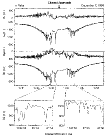 |
Figure 2. Magnetometer data from the Io flyby [Kivelson et al, 1996] in right-handed
System III (1995) coordinates. The expanded panels show in detail the mirror-mode structures seen on the edges of the Io
wake. These appear as a series of dips in the magnetic field magnitude and in B , where
, where  the north-south (approximately field-aligned) direction in this coordinate system. Br is radially outward
from Jupiter, and B the north-south (approximately field-aligned) direction in this coordinate system. Br is radially outward
from Jupiter, and B is azimuthal.
is azimuthal.
|
By individually examining each of the |B| dips using a triple cross product method, Russell
et al. [1999] find that the observed mirror-mode k-vectors are aligned with  kB
between 54o and 85o to the field. The duration of the |B| dips (Figure 2) is of the order of 3 s,
during which time Galileo travels ~60 km relative to Io (approximately perpendicular to the flow), while the plasma travels
of the order of between 180 and 60 km (slowing down adjacent to wake) in the plane approximately perpendicular to the
B direction. This gives an idea of the scale size of the structures. The Larmor radius
kB
between 54o and 85o to the field. The duration of the |B| dips (Figure 2) is of the order of 3 s,
during which time Galileo travels ~60 km relative to Io (approximately perpendicular to the flow), while the plasma travels
of the order of between 180 and 60 km (slowing down adjacent to wake) in the plane approximately perpendicular to the
B direction. This gives an idea of the scale size of the structures. The Larmor radius  L (= mv
L (= mv / qB) of SO2+ in this region is ~33 km. The gyro-orbit path lengths 2
/ qB) of SO2+ in this region is ~33 km. The gyro-orbit path lengths 2
 L are ~200 km for SO2+, 100 km for S+, and 50 km for O+, and are therefore
of the same order as the mirror-mode structure scale size. This scale size is considerably smaller than those reported in planetary magnetosheath
regions (between the magnetopause and bow shock), because of the high ambient field strength (hence small
L are ~200 km for SO2+, 100 km for S+, and 50 km for O+, and are therefore
of the same order as the mirror-mode structure scale size. This scale size is considerably smaller than those reported in planetary magnetosheath
regions (between the magnetopause and bow shock), because of the high ambient field strength (hence small
 L ) at the location of Io deep in the Jovian magnetosphere. Io orbits at a distance of 5.9 RJ,
where the ambient field is ~1800 nT, while the Jovian magnetopause stands off ~60 RJ at the subsolar point
depending on external solar wind pressure and internal magnetodisk mass loading [e.g., Slavin et al., 1985;
Khurana, 1997; Huddleston et al., 1998b, and references therein].
L ) at the location of Io deep in the Jovian magnetosphere. Io orbits at a distance of 5.9 RJ,
where the ambient field is ~1800 nT, while the Jovian magnetopause stands off ~60 RJ at the subsolar point
depending on external solar wind pressure and internal magnetodisk mass loading [e.g., Slavin et al., 1985;
Khurana, 1997; Huddleston et al., 1998b, and references therein].
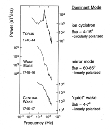 |
Figure 3. Examples of power spectra observed by Galileo in the Io torus and wake regions. The observed large-amplitude mirror-mode structures are approximately linearly polarized, with k vectors aligned 60o-85o to B [Russell et al, this issue]. |
The mirror-mode waves near Io were observed in regions of steep gradients in the plasma parameters,
as seen in Figure 4, occurring approximately where the corotating torus plasma flow is deflected around Io, adjacent to the
cold, stagnant wake plasma. Here the field strength depression toward an average ~1200 nT is seen (see also Figure 2), the
plasma velocity falls from an enhanced value of ~80 km/s down to nearly zero in the center of the cold wake [Frank et
al., 1996], and ion densities are increasing rapidly due to pickup of ionized volcanic gases in close proximity to Io.
The middle panel of Figure 4 shows an estimate of the source pickup density obtained by Bagenal [1997] using a total
density profile derived from both plasma analyzer (PLS) [Frank et al., 1996] and plasma wave subsystem (PWS)
[Gurnett et al., 1996] observations and subtracting an average torus background density contribution. Plotted also
is an SO2+ component density estimated from the observed ion cyclotron wave power, using a free-energy analysis
of the ion pitch angle scattering [Huddleston et al., 1998a].
 |
Figure 4.Averaged profiles of plasma parameters from the Galileo-Io flyby. From top to bottom the panels show magnetic field magnitude [Kivelson et al., 1996], ion velocity, and temperature from the plasma analyzer instrument [Frank et al., 1996]; total Iogenic source density estimated by Bagenal [1997] (see text) and SO2+ component pickup density estimated by Huddleston et al. [1998a]; and comparison of the RMS amplitudes of compressional and transverse components of B. |
In the bottom panel of Figure 4 we compare the RMS amplitudes of compressional and transverse
fluctuations through the flyby region. This clearly shows that the regions in which the mirror mode dominates are very
narrow. Also, note that transverse power is still evident within the "quiet" wake region where there are no mirror-mode
structures observed (Figure 4, bottom panel), and thus it is unlikely that transverse fluctuations through these regions are
merely due to "nonideal" alignments of mirror-mode phase fronts for  kB < 90o.
kB < 90o.
3. Mirror-Mode Instability Criterion
The mirror mode arises in high-beta plasmas when there is a pressure anisotropy, with P >> P//. If there are inhomogeneities in the plasma, where the magnetic tension forces cannot
contain the perpendicular plasma pressure, the instability leads to magnetic "bottle" structures. Figure 5 is an idealized
schematic of the mirror mode. A spacecraft passing through these structures will see the magnetic field strength and plasma
density varying in antiphase. By conservation of particle magnetic moment, the plasma is "squeezed" from strong field
regions into weak field regions by the mirror force (while the particles' total energy remains unchanged). Since the mirror
mode has zero phase velocity (nonpropagating) in the plasma frame, particles with V// = 0 can be termed
"resonant" with the zero-frequency "wave" [Southwood and Kivelson, 1993]. Nonresonant particles will respond to
variations in B along the field lines due to their parallel motion, while resonant particles will see mostly temporal
changes in B. In addition, strong gradients in the ambient field strength, such as those seen close to Io, may be
important if B significantly changes over the scale size of the ion gyro-orbit.
>> P//. If there are inhomogeneities in the plasma, where the magnetic tension forces cannot
contain the perpendicular plasma pressure, the instability leads to magnetic "bottle" structures. Figure 5 is an idealized
schematic of the mirror mode. A spacecraft passing through these structures will see the magnetic field strength and plasma
density varying in antiphase. By conservation of particle magnetic moment, the plasma is "squeezed" from strong field
regions into weak field regions by the mirror force (while the particles' total energy remains unchanged). Since the mirror
mode has zero phase velocity (nonpropagating) in the plasma frame, particles with V// = 0 can be termed
"resonant" with the zero-frequency "wave" [Southwood and Kivelson, 1993]. Nonresonant particles will respond to
variations in B along the field lines due to their parallel motion, while resonant particles will see mostly temporal
changes in B. In addition, strong gradients in the ambient field strength, such as those seen close to Io, may be
important if B significantly changes over the scale size of the ion gyro-orbit.
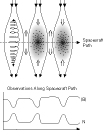 |
Figure 5. Schematic illustration of the warped magnetic field structure of the mirror mode and idealized anticorrelated field magnitude and density variations along a hypothetical spacecraft path through these structures. [Adapted from Treumann and Baumjohann, 1996; Kivelson and Southwood, 1996]. |
The instability criterion [e.g., Hasegawa, 1969; Siscoe, 1983] can be expressed
 | (1) |
where 
 = P
= P / (B2/2µ0). Since
/ (B2/2µ0). Since  values are typically less than 1 in the near-Io environment, a substantial pressure anisotropy is needed in order to
overcome the instability threshold. Previous estimations of pickup ion densities for SO2+ [Huddleston et
al., 1998a] and the total Iogenic ion source [Bagenal, 1997] allow us to estimate the pickup ion perpendicular
pressure assuming these new ions form a ring-type distribution gyrating about the field lines with velocity
V
values are typically less than 1 in the near-Io environment, a substantial pressure anisotropy is needed in order to
overcome the instability threshold. Previous estimations of pickup ion densities for SO2+ [Huddleston et
al., 1998a] and the total Iogenic ion source [Bagenal, 1997] allow us to estimate the pickup ion perpendicular
pressure assuming these new ions form a ring-type distribution gyrating about the field lines with velocity
V = Vring equal to the instantaneous flow velocity of the background plasma past Io. We calculate a
profile of P
= Vring equal to the instantaneous flow velocity of the background plasma past Io. We calculate a
profile of P pickup = 1/2 m Npickup V 2ring along the Galileo flyby
trajectory using an effective average mass of 21 amu, appropriate for the ions of dissociated SO2. In Figure 6a,
this calculation is compared with the observed plasma pressure and the magnetic pressure. Assuming that the plasma pressure
(Pi = N kTi ) observed by the PLS instrument [Frank et al., 1996] includes both
the pressure of the background torus plasma (assumed isotropic) and the pressure of all the new pickup ions (ring
distribution), we can infer P
pickup = 1/2 m Npickup V 2ring along the Galileo flyby
trajectory using an effective average mass of 21 amu, appropriate for the ions of dissociated SO2. In Figure 6a,
this calculation is compared with the observed plasma pressure and the magnetic pressure. Assuming that the plasma pressure
(Pi = N kTi ) observed by the PLS instrument [Frank et al., 1996] includes both
the pressure of the background torus plasma (assumed isotropic) and the pressure of all the new pickup ions (ring
distribution), we can infer P and P// profiles using our estimated pickup ion perpendicular pressure contribution. Since
3Pi = 2P
and P// profiles using our estimated pickup ion perpendicular pressure contribution. Since
3Pi = 2P + P// , and P// = Pbg only, while the contributions to P
+ P// , and P// = Pbg only, while the contributions to P are Pbg + P
are Pbg + P pickup , then
pickup , then
 | (2) | |||
| (3) |
These estimations are shown in Figure 6b. Note that for two points
near 1751 UT (outbound), the estimated total pickup ion perpendicular pressure is too high to have been included in the
Pi measured by the PLS instrument. Here P// cannot be calculated from (3), so instead
we extrapolate P// values for these two points.
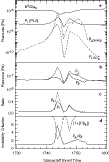 |
Figure 6. (a) Comparison of the observed magnetic field and ion plasma pressure [Kivelson et
al., 1996; Frank et al., 1996] and the estimated pickup ion perpendicular pressure. (b) The inferred
perpendicular and parallel components of ion pressure (see text). (c) Perpendicular plasma beta calculated from P and overall effective beta (from observed Pi ). (d) Evaluation of the mirror-mode instability
criterion (left- and right-hand sides of equation (1)), which is satisfied where the lines overlap, at ~1744 UT.
and overall effective beta (from observed Pi ). (d) Evaluation of the mirror-mode instability
criterion (left- and right-hand sides of equation (1)), which is satisfied where the lines overlap, at ~1744 UT. |
Figure 6c shows the perpendicular ion plasma 
 calculated from P
calculated from P , which is of the order of 0.05 in the torus and increases to ~0.7 on the edge of the Io wake. The instability criterion
is evaluated in Figure 6d, indicating instability where the traces of (1+1/
, which is of the order of 0.05 in the torus and increases to ~0.7 on the edge of the Io wake. The instability criterion
is evaluated in Figure 6d, indicating instability where the traces of (1+1/
 ) and P
) and P /P// overlap. Because of the uncertainties in the estimated parameters, these numbers should be taken
to be illustrative rather than exact. In fact, while we are successful in finding the criterion satisfied near 1744 UT, we
are not so successful near 1748 UT (outbound pass). However, the important result is that conditions adjacent to the Io
wake are most appropriate for mirror-mode growth, where |B| is depressed and high pickup ion densities provide a
large pressure anisotropy that can approach and exceed the threshold for instability. This is indeed the region in which
the mirror-mode structures were observed. Near the center of the wake, low plasma velocities imply low pickup speeds (i.e.,
low Vring), and hence no significant perpendicular pressure enhancement is provided by the pickup ions
there (see Figure 6). Farther from Io, where the ion cyclotron waves were seen,
/P// overlap. Because of the uncertainties in the estimated parameters, these numbers should be taken
to be illustrative rather than exact. In fact, while we are successful in finding the criterion satisfied near 1744 UT, we
are not so successful near 1748 UT (outbound pass). However, the important result is that conditions adjacent to the Io
wake are most appropriate for mirror-mode growth, where |B| is depressed and high pickup ion densities provide a
large pressure anisotropy that can approach and exceed the threshold for instability. This is indeed the region in which
the mirror-mode structures were observed. Near the center of the wake, low plasma velocities imply low pickup speeds (i.e.,
low Vring), and hence no significant perpendicular pressure enhancement is provided by the pickup ions
there (see Figure 6). Farther from Io, where the ion cyclotron waves were seen,  ~0.05, and the background torus plasma dominates over the new source contribution; hence P
~0.05, and the background torus plasma dominates over the new source contribution; hence P
 P// , and the mirror mode is stabilized. Thus the mirror mode is confined to narrow spatial
regions near Io.
P// , and the mirror mode is stabilized. Thus the mirror mode is confined to narrow spatial
regions near Io.
4. Dispersion Analysis
A linear, warm plasma dispersion analysis is performed for multiple ion species plus electrons, each described using bi-Maxwellian anisotropic distributions, for the conditions appropriate to the mirror-mode-dominated regions adjacent to the Io wake. Bi-Maxwellians are appropriate for our purposes since it is the anisotropy that drives both the ion cyclotron and mirror-mode growth. We chose average values of B=1200 nT (see Figure 2) and total density N = 10,000 /cm3 for both the ions (summed over species) and electrons to preserve quasi-neutrality. The background density components (Nbg for the corotating torus plasma) are based on the torus species composition observed by Voyager [Bagenal, 1994] and wake observations by Galileo [Frank et al., 1996], for a plasma density of the order of 4000/cm3 (as was used by Huddleston et al. [1997] and Warnecke et al. [1997]). The enhancement in densities observed above background near the Io wake (i.e., ~6000/cm3) are the new pickup ions added into ring distributions, which we include as Nring while maintaining the appropriate species composition ratios. These densities are listed in Table 1.

For each ion species, an approximate effective
perpendicular temperature T is the calculated average over background and ring density contributions, assuming realistic torus background
temperatures of T
is the calculated average over background and ring density contributions, assuming realistic torus background
temperatures of T bg = T// bg = Tbg = 100 eV and ring T
bg = T// bg = Tbg = 100 eV and ring T ring calculated from Vring for the appropriate species ion mass. Thus T
ring calculated from Vring for the appropriate species ion mass. Thus T is obtained from
is obtained from
 | (4) |
 values estimated from (4) are listed in Table 1 under case A. Note that the entire SO2+ component is put into a
ring distribution because the dissociation rate of these molecular ions precludes a significant background component in the
corotating torus plasma (see discussions by Huddleston et al. [1998a], for example). This results in a particularly
high anisotropy for the SO2+ component species.
values estimated from (4) are listed in Table 1 under case A. Note that the entire SO2+ component is put into a
ring distribution because the dissociation rate of these molecular ions precludes a significant background component in the
corotating torus plasma (see discussions by Huddleston et al. [1998a], for example). This results in a particularly
high anisotropy for the SO2+ component species.
As an initial step, we investigate the effect of the plasma anisotropy on the growth rates of the
mirror mode and the SO2+ ion cyclotron mode, which is the dominant wave in the torus. Figure 7a shows how the
growth rate and propagation angle (at peak growth rate) vary with anisotropy if the anisotropy is the same for all species
present, while Figure 7b investigates the effect of varying only the SO2+ anisotropy (with the remaining species
anisotropies as listed in Table 1, case A). It is clear from Figure 7 that the growth rate of the mirror mode depends on
the effective anisotropy of all the species present, while varying just the SO2+ anisotropy (a minor component by
number density) has little effect. The SO2+ ion cyclotron mode, however, clearly depends very strongly on the
SO2+ anisotropy in both Figures 7a and 7b, as expected, and will grow most rapidly when the SO2+
anisotropy is high but that of the other component species is kept low. In both cases, the mirror-mode propagation angle
decreases with increasing anisotropy.
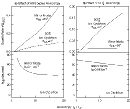 |
Figure 7. Variation of peak growth rate and peak propagation angle with (a) the anisotropy of all ion species and (b) the anisotropy of the SO2+ component only, while maintaining the remaining species anisotropies at the values of Table 1, case A. |
It is unfortunate that the actual ion distribution anisotropies near Io at the time of the Galileo flyby are not known. (These parameters have not been made available from the plasma instruments, at least not to date). For our dispersion analysis, the idealized pickup ion "ring" geometry is assumed, and the relative contribution of the thermalized background torus plasma can only be estimated. A total torus background density of ~4000 ions/cm3 (all species) is expected to be appropriate, at least throughout the region in which ion cyclotron waves were observed and in toward the edge of the wake. However, this thermalized component density is expected to decline in the regions sampled as Galileo moves behind Io into the wake. The transition will most likely be occurring across the wake edge, our region of interest, while the pickup ion density is simultaneously increasing rapidly and the plasma velocity is beginning to ramp down (see Figure 4). We will therefore consider three cases of effective anisotropies in order to investigate the wave dispersion.
Figure 8 presents the dispersion relation solutions for the anisotropy values denoted "case A" in
Table 1. In this case, we use the observed ion component densities and our best estimates of the temperature anisotropies
as listed in the table, with T values calculated from (4), assuming the background component is present at 4000/cm3 as appropriate to the
outermost edge of the region of observed mirror-mode growth. In order to limit the number of species in our code, the O+
and S++ densities are combined as a single O+ component since the gyroresonance is the same for both, (i.e., m/q=16).
We compare the resulting SO2+ ion cyclotron wave mode with the mirror mode. For the case A conditions, the
mirror mode-growth peaks at
values calculated from (4), assuming the background component is present at 4000/cm3 as appropriate to the
outermost edge of the region of observed mirror-mode growth. In order to limit the number of species in our code, the O+
and S++ densities are combined as a single O+ component since the gyroresonance is the same for both, (i.e., m/q=16).
We compare the resulting SO2+ ion cyclotron wave mode with the mirror mode. For the case A conditions, the
mirror mode-growth peaks at  kB = 62o.
The SO2+ ion cyclotron mode has the dominant growth rate for this case, while the cyclotron
resonant modes of O+ and S+ are damped. This is basically the same situation as observed in the regions of the near-Io
torus, where SO2+ ion cyclotron waves dominate (see Figure 1), i.e., from just outside the wake edge out to more
than 10 RIo.
kB = 62o.
The SO2+ ion cyclotron mode has the dominant growth rate for this case, while the cyclotron
resonant modes of O+ and S+ are damped. This is basically the same situation as observed in the regions of the near-Io
torus, where SO2+ ion cyclotron waves dominate (see Figure 1), i.e., from just outside the wake edge out to more
than 10 RIo.
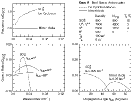 |
Figure 8. Solutions of the dispersion relation for the parameters given in Table 1, with the anisotropies of case A. Frequency and growth rate are normalized to the SO2+ gyrofrequency (1.8 rad/s for |B|= 1200 nT). In case A, the S+ and O+ ion cyclotron modes are damped (not shown). |
Next, for illustrative purposes we investigate the relative growth rates that would result in a
hypothetical case where all species have the same anisotropy, while we maintain the observed density ratios (Table 1, third
column from left) for the Io wake edge. In case B we arbitrarily choose a high anisotropy (T /T// =10) for all heavy ion species present, for which the dispersion solutions are presented in
Figure 9. In this case, the overpowering density of the O+, S++ (combined) component prevails, despite the lower ion mass,
and produces the dominant ion cyclotron mode. The mirror-mode growth rate peaks at a propagation angle of 45o and is 80% of
the dominant mode peak growth.
/T// =10) for all heavy ion species present, for which the dispersion solutions are presented in
Figure 9. In this case, the overpowering density of the O+, S++ (combined) component prevails, despite the lower ion mass,
and produces the dominant ion cyclotron mode. The mirror-mode growth rate peaks at a propagation angle of 45o and is 80% of
the dominant mode peak growth.
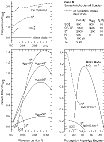 |
Figure 9. Dispersion relation solutions for case B (see Table 1), with T /T// =10 for all the heavy ion species. For the mirror mode, this case has the highest effective
anisotropy (over all species present).
/T// =10 for all the heavy ion species. For the mirror mode, this case has the highest effective
anisotropy (over all species present).
|
As discussed above, there are no observations to tell us how the contribution of the isotropized background torus plasma declines toward the innermost (Io side) of the wake edge in the region of observed mirror-mode growth; however, cases A and B give us a good indication of the conditions that must exist in order for the mirror mode to become dominant there. For the mirror mode to dominate, the SO2+ cannot be the only highly anisotropic species component (as in case A). On the other hand, sufficient isotropic torus background must still be present in order to reduce the effective anisotropies of O+, S++, and S+ to less than that of the SO2+component and hence partially quench the ion cyclotron growth rates (of O+ in particular) to below that of case B.
For our final case, we consider the following: As discussed previously, on crossing the edge of the
wake inbound toward Io, both the addition of highly anisotropic new ions and the decline of background torus contributions
will begin to increase the S+ and O+ anisotropies above the values of case A. In the central wake itself we envisage that
the background component is excluded entirely, having been deflected around Io, but flow velocities are observed to be
stagnant there (Figures 1 and 4) and hence there is little pickup energy imparted to new ions in this region (ring V = Vplasma is small), as evidenced by the low level of wave activity observed there. Nevertheless, on the wake-edge
transition region of interest the flow velocity is significant and the estimated pickup ion
P
= Vplasma is small), as evidenced by the low level of wave activity observed there. Nevertheless, on the wake-edge
transition region of interest the flow velocity is significant and the estimated pickup ion
P is considerable (section 3 and Figure 6). Since the transition in the contribution ratio of the thermalized component
across the wake edge has not been characterized observationally, in our dispersion analysis we have undertaken a parameter
study to find a representative intermediate case. Case C is such an example in which the three cyclotron mode growth rates
are more similar to each other, and for which the mirror mode dominates. These dispersion solutions are shown in Figure 10
and are obtained by doubling the anisotropies of O+, S++, and S+ in case C compared with those represented in case A. Note
that since there is no significant SO2+ component in the thermalized background torus plasma, the SO2+
anisotropy is unchanged from that of case A and remains the most highly anisotropic component species.
is considerable (section 3 and Figure 6). Since the transition in the contribution ratio of the thermalized component
across the wake edge has not been characterized observationally, in our dispersion analysis we have undertaken a parameter
study to find a representative intermediate case. Case C is such an example in which the three cyclotron mode growth rates
are more similar to each other, and for which the mirror mode dominates. These dispersion solutions are shown in Figure 10
and are obtained by doubling the anisotropies of O+, S++, and S+ in case C compared with those represented in case A. Note
that since there is no significant SO2+ component in the thermalized background torus plasma, the SO2+
anisotropy is unchanged from that of case A and remains the most highly anisotropic component species.
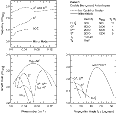 |
Figure 10. Dispersion relation solutions for case C (see Table 1). In this case, O+ and S++ species are included separately in the dispersion but produce a combined mode (the gyroresonance is for the same mass/q). The mirror mode dominates. Parameters from this result are listed in Table 2. |
The total possible ion cyclotron wave energy available in case C is divided between the individual
modes (of different gyroresonances) corresponding to the multiple species anisotropic distributions present. Thus, while
each of the ion cyclotron modes depends upon the anisotropy of one particular gyroresonant ion species only, the total
pressure anisotropy of all species contributes to the mirror-mode instability (see also Figure 7). Table 2 presents the wave
parameters obtained from case C (Figure 10). For the mirror mode at peak growth, the dominant wavenumber k = 0.07/km
corresponds to a scale size
 = 2
= 2 /k = 90 km, which is comparable to the observed scale size of the |B| dips (section 2).
/k = 90 km, which is comparable to the observed scale size of the |B| dips (section 2).

5. Conclusions
The present paper has addressed the issues of (1) how the mirror mode can grow in a high |B|,
low- plasma and (2) under what circumstances the mirror mode dominates over ion cyclotron modes near Io. The mirror mode is
prominent only in a narrow spatial region on the edges of the Io wake. Farther from Io in the torus, the corotating
"background" plasma dominates the plasma pressure, i.e., P
plasma and (2) under what circumstances the mirror mode dominates over ion cyclotron modes near Io. The mirror mode is
prominent only in a narrow spatial region on the edges of the Io wake. Farther from Io in the torus, the corotating
"background" plasma dominates the plasma pressure, i.e., P
 P// , and the SO2+
ion cyclotron mode is dominant. The corotating background (thermalized) torus
plasma is deflected around Io, and in the center of the cold Io wake the plasma is stagnant (®
1 km/s flow velocity observed). Hence local pickup velocities are very low, the perpendicular pressure contribution from
locally picked up ions is small, and there is very little energy for pickup ion wave generation in the central wake.
However, at the edges of the wake where |B| is depressed and pickup ion density is increasing, injection
Vring is significant and the P
P// , and the SO2+
ion cyclotron mode is dominant. The corotating background (thermalized) torus
plasma is deflected around Io, and in the center of the cold Io wake the plasma is stagnant (®
1 km/s flow velocity observed). Hence local pickup velocities are very low, the perpendicular pressure contribution from
locally picked up ions is small, and there is very little energy for pickup ion wave generation in the central wake.
However, at the edges of the wake where |B| is depressed and pickup ion density is increasing, injection
Vring is significant and the P /P// ratio is then sufficient to overcome the mirror-mode instability threshold (as seen in Figure 6).
/P// ratio is then sufficient to overcome the mirror-mode instability threshold (as seen in Figure 6).
The more species there are in the plasma, the more different ion cyclotron modes are possible, but the individual growth rates for these modes will be lower compared with those for a single-species plasma of the same total N. On the other hand, the mirror mode is fed by the combined anisotropy of all the ion species present and can therefore dominate in a multispecies plasma. At Io, the mirror mode is observed in a region where there is a significant deflected plasma flow velocity, an increased density of pickup ions, and declining contributions from the isotropic background torus plasma. However, it is important that there is still enough isotropized O+, S+, and S+ to partially quench the ion cyclotron modes of these species. We have been successful in obtaining a dominant mirror-mode solution to the dispersion (in case C, Figure 10) for realistic parameters in the near-Io environment.
Once mirror-mode structures begin to form, the large spatial gradients in |B| created at the "dips" (and those gradients already present in N due to the Io pickup source) will act to suppress the ion cyclotron resonance if finite V// takes ions along B where they drop out of resonance. Additionally, if the scale length over which the resonance condition varies is smaller than the heavy ion gyro-orbit, then the resonance would become "confused." The gradients in the ambient plasma parameters will also affect the dispersion for the mirror mode. For the future, a nonlinear analysis of the dispersion at Io may help to determine the importance of these effects.
Acknowledgments. We are indebted to the Galileo magnetometer team and to all those responsible for the success of the Galileo mission. We thank L.A. Frank and the PLS team for the use of the published PLS data. This work was supported by the National Aeronautics and Space Administration through Jet Propulsion Laboratory grants JPL 958510 and JPL 958694. R.J.S. and D.E.H. acknowledge support of grant NAG 5-6965. The travel of X.B.C. to collaborate at UCLA is supported by the UC MEXUS-CONACYT program. This is UCLA-IGPP publication 5072.
Michel Blanc thanks Michele K. Dougherty and another referee for their assistance in evaluating this paper.
References
Anderson, B. J., and S. A. Fuselier, Magnetic pulsations from 0.1 to 4.0 Hz and associated plasma properties in the Earth's subsolar magnetosheath and plasma depletion layer, J. Geophys. Res., 98, 1461, 1993.
Bagenal, F., Empirical model of the Io plasma torus: Voyager measurements, J. Geophys. Res., 99, 11,043, 1994.
Bagenal, F., The ionization source near Io from Galileo wake data, Geophys. Res. Lett., 24, (17), 2111, 1997.
Balogh, A., M. K. Dougherty, R. J. Forsyth, D. J. Southwood, E. J. Smith, B. T. Tsurutani, N. Murphy, and M. E. Burton, Magnetic field observations in the vicinity of Jupiter during the Ulysses flyby, Science, 257, 1515, 1992.
Barnes, A., Collisionless damping of hydromagnetic waves, Phys. Fluids, 9, 1483, 1966.
Bavassano-Cattaneo, M. B., C. Basile, G. Moreno, and J. D. Richardson, Evolution of mirror structures in the magnetosheath of Saturn from the bow shock to the magnetopause, J. Geophys. Res., 103, 11,961, 1998.
Brinca, A. L., Cometary linear instabilities: From profusion to perspective, in Cometary Plasma Processes, Geophys. Monogr. Ser. vol. 61, edited by A. D. Johnstone, p. 211-221, AGU, Washington, D. C., 1991.
Brinca, A. L., and B. T. Tsurutani, Unusual characteristics of electromagnetic waves excited by cometary newborn ions with large perpendicular energies, Astron. Astrophys., 187, 311, 1987.
Brinca, A. L., and B. T. Tsurutani, Influence of multiple ion species on low-frequency electromagnetic wave instabilities, J. Geophys. Res., 94, 13,565, 1989.
Chandrasekhar, S., A. N. Kaufman, and K. M. Watson, The stability of the pinch, Proc. R. Soc. London, Ser. A, 245, 435, 1958.
Frank, L. A., W. R. Paterson, K. L. Ackerson, V. M. Vasyliunas, F. V. Coroniti, and S. J. Bolton, Plasma observations at Io with the Galileo spacecraft, Science, 274, 394, 1996.
Galeev, A. A., Plasma processes in the outer coma, in Comets in the Post-Halley Era, vol. 2, edited by R. L. Newburn Jr. et al., pp. 1145-1169, Kluwer, Boston, 1991.
Gary, S. P., The mirror and ion cyclotron anisotropy instabilities, J. Geophys. Res., 97, 8519, 1992.
Gary, S. P., S. A. Fuselier, and B. J. Anderson, Ion anisotropy instabilities in the magnetosheath, J. Geophys. Res., 98, 1481, 1993.
Glassmeier, K. H., U. Motschmann, C. Mazelle, F. M. Neubauer, K. Sauer, S. A. Fuselier, and M. H. Acuñ a, Mirror modes and fast magnetoacoustic waves near the magnetic pileup boundary of comet P/Halley, J. Geophys. Res., 98, 20,955, 1993.
Gurnett, D. A., W. S. Kurth, A. Roux, S. J. Bolton, and C. F. Kennel, Galileo plasma wave observations in the Io plasma torus and near Io, Science, 274, 391, 1996.
Hasegawa, A., Drift mirror instability in the magnetosphere, Phys. Fluids, 12, 2642, 1969.
Hasegawa, A., Plasma Instabilities and Nonlinear Effects, Springer-Verlag, New York, 1975.
Hubert, D., C. Perche, C. C. Harvey, C. Lacombe, and C. T. Russell, Observation of mirror waves downstream of a quasi-perpendicular shock, Geophys. Res. Lett., 16, 159, 1989.
Huddleston D. E., R. J. Strangeway, J. Warnecke, C. T. Russell, M. G. Kivelson, and F. Bagenal, Ion cyclotron waves in the Io torus during the Galileo encounter: Warm plasma dispersion analysis, Geophys. Res. Lett., 24, 2143, 1997.
Huddleston, D. E., R. J. Strangeway, J. Warnecke, C. T. Russell, and M. G. Kivelson, Ion cyclotron waves in the Io torus: Wave dispersion, free energy analysis, and SO2+ source rate estimates, J. Geophys. Res., 103, 19,887, 1998a.
Huddleston, D. E., C. T. Russell, M. G. Kivelson, K. K. Khurana, and L. Bennett, Location and shape of the Jovian magnetopause and bow shock, J. Geophys. Res., 103, 20,075, 1998b.
Kaufmann, R. L., J. T. Horng, and A. Wolfe, Large-amplitude hydromagnetic waves in the inner magnetosheath, J. Geophys. Res., 75, 4666, 1970.
Khurana, K. K., Euler potential models of Jupiter’s magnetospheric field, J. Geophys. Res., 102, 11295, 1997.
Kivelson, M. G., and D. J. Southwood, Mirror instability, 2, The mechanism of nonlinear saturation, J. Geophys. Res., 101, 17,365, 1996.
Kivelson, M. G., K. K. Khurana, R. J. Walker, J. Warnecke, C. T. Russell, J. A. Linker, D. J. Southwood, and C. Polanskey, Io's interaction with the plasma torus: Galileo magnetometer report, Science, 274, 396, 1996.
Lee, M. A., Comparison of the Halley and Giacobini-Zinner plasma environments, in Plasma Environments of Non-Magnetic Planets, COSPAR colloquia vol. 4, edited by T. I. Gombosi, pp. 9-18, Pergamon, Tarrytown, N.Y., 1992.
McKean, M. E., D. Winske, and S. P. Gary, Mirror and ion cyclotron anisotropy instabilities in the magnetosheath, J. Geophys. Res., 97, 19,421, 1992.
Pantellini, F. G. E., A model of the formation of stable nonpropagating magnetic structures in the solar wind based on the nonlinear mirror instability, J. Geophys. Res., 103, 4789, 1998.
Price, C. P., D. W. Swift, and L.-C. Lee, Numerical simulation of nonoscillatory mirror waves at the Earth's magnetosheath, J. Geophys. Res., 91, 101, 1986.
Russell, C. T., G. Le, K. Schwingenschuh, W. Riedler, and Y. Yeroshenko, Mirror mode waves at Comet Halley, in Cometary Plasma Processes, Geophys. Monogr. Ser., vol. 61, edited by A. D. Johnstone, pp. 161-169, AGU, Washington, D.C., 1991.
Russell, C. T., F. Bagenal, A. F. Cheng, W.-H. Ip, A. Roux, W. H. Smyth, S. J. Bolton, and C. A. Polanskey, Io's interaction with the Jovian magnetosphere, Eos trans., AGU, 78(9), 93, 1997.
Russell, C. T., M. G. Kivelson, K. K. Khurana, and D. E. Huddleston, Magnetic fluctuations close to Io: Ion cyclotron and mirror mode wave properties, Planet. Space Sci., 47, 644, 1999.
Russell, C. T., D. E. Huddleston, R. J. Strangeway, X. Blanco-Cano, M. G. Kivelson, K. K. Khurana, L. A. Frank, W. Patterson, D. A. Gurnett, and W. S. Kurth, Mirror-mode structures at the Galileo-Io flyby: Observations, J. Geophys. Res., this issue.
Siscoe, G. L., Solar system magnetohydrodynamics, in Solar Terrestrial Physics, edited by R. L. Carovillano and J. M. Forbes, pp. 11-100, D. Reidel Norwell, Mass., 1983.
Slavin, J. A., E. J. Smith, J. R. Spreiter, and S. S. Stahara, Solar wind flow about the outer planets: Gas dynamic modeling of the Jupiter and Saturn bow shocks, J. Geophys. Res., 90, 6275, 1985.
Smyth, W. H., and M. L. Marconi, An initial look at the Iogenic SO2+ source during the Galileo flyby of Io, J. Geophys. Res., 103, 9083, 1998.
Southwood, D. J., and M. G. Kivelson, Mirror instability, 1, Physical mechanism of linear instability, J. Geophys. Res., 98, 9181, 1993.
Treumann, R. A., and W. Baumjohann, Advanced Space Plasma Physics, Imp. Coll. Press, London, 1996.
Tsurutani, B. T., E. J. Smith, R. R. Anderson, K. W. Ogilvie, J. D. Scudder, D. N. Baker, and S. J. Bame, Lion roars and nonoscillatory drift mirror waves in the magnetosheath, J. Geophys. Res., 87, 6060, 1982.
Tsurutani, B. T., D. J. Southwood, E. J. Smith, and A. Balogh, Nonlinear magnetosonic waves and mirror mode structures in the March 1991 Ulysses interplanetary event, Geophys. Res. Lett., 19, 1267, 1992.
Tsurutani, B. T., D. J. Southwood, E. J. Smith, and A. Balogh, A survey of low-frequency waves at Jupiter: The Ulysses encounter, J. Geophys. Res., 98, 21,203, 1993.
Violante, L., M. B. Bavassano-Cattaneo, G. Moreno, and J. D. Richardson, Observations of mirror waves and plasma depletion layer upstream of Saturn's magnetopause, J. Geophys. Res., 100, 12,047, 1995.
Warnecke, J., M. G. Kivelson, K. K. Khurana, D. E. Huddleston, and C. T. Russell, Ion cyclotron waves observed at Galileo's Io encounter: Implications for neutral cloud distribution and plasma composition, Geophys. Res. Lett., 24, 2139, 1997.
Winterhalter, D., M. Neugebauer, B. E. Goldstein, E. J. Smith, S. J. Bame, and A. Balogh, Ulysses field and plasma observations of magnetic holes in the solar wind and their relation to mirror-mode structures, J. Geophys. Res., 99, 23,371, 1994.
 Back to CT Russell's page
Back to CT Russell's page
 More On-line Resources
More On-line Resources Back to the SSC Home Page
Back to the SSC Home Page